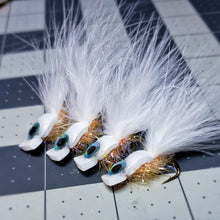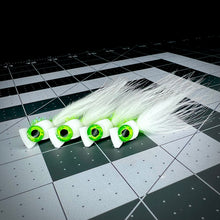
Stripping flies at Pyramid Lake is a very specialized technique that requires specialized flies to be effective. Due to the sandy bottom, full sinking and shooting head lines are used to drag right through the sand. Like many of the popular retrieving flies at the lake, my Cyclops pattern incorporates a foam back and head that cause the fly to slowly float upward, and when the line is pulsed, skitter and dive. As it is stripped through the water, the Cyclops strongly resembles the behavior of a wounded baitfish attempting to flee.
This pattern is really just my take on Doug Ouellette's Popcorn Beetle, with a couple of important modifications. I have found that the White Peach color pallete used in this fly is often preferred by the largest Lahontan Cutthroat, but I like to fish White and Black in tandem so that fish seeking a darker profile will strike as well. Key to its success is the large reflective eye mounted on top of the foam. The eye not only serves as a triggering cue to predatory trout, it also serves as a brace for the foam ahead of the tie down point, helping the fly keep its shape after it gets wet and chewed on. I use a strong, transparent adhesive to firmly bond the eye on top of the foam.
When I tie these flies, I have found that the precise geometry and perfect symmetry of the head is crucial in getting them to swim straight and wobble. If they are made with haste or without consideration of symmetry, the resulting fly will just spin as you retrieve it, or only dart to one side. The fish definitely prefer flies that swim straight, and have that darting, swooping action. Although they are not complicated per se, the precision required to perfectly angle and tune the bug is time consuming. By using glue to hold the eye and foam together and a durable construction, along with stout hooks that will not bend out on fish and are strong enough to pull in the frequently encountered sunken tumbleweed, I get a lot of fish out of each bug before needing to retire them.













